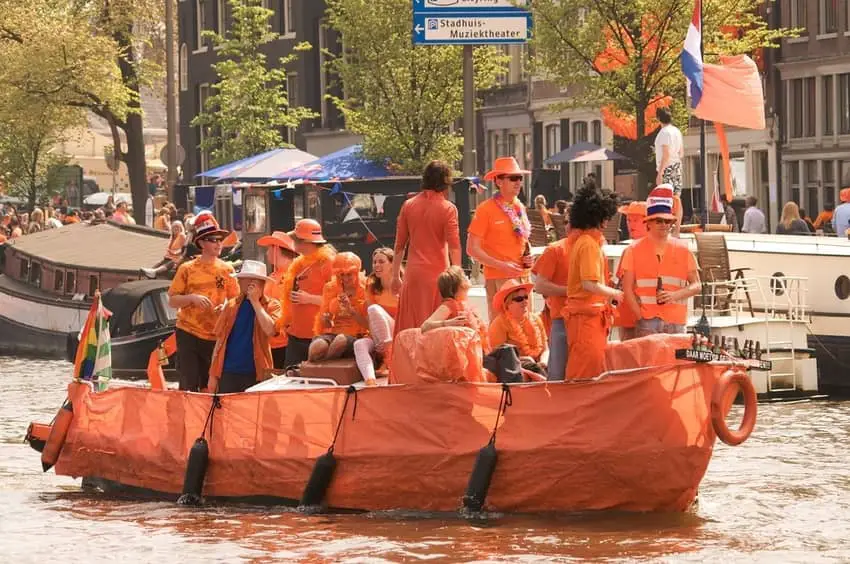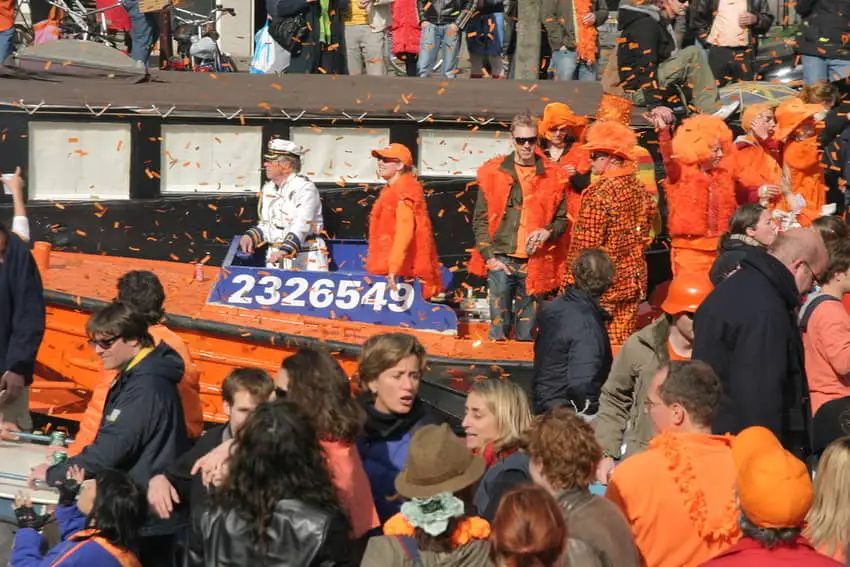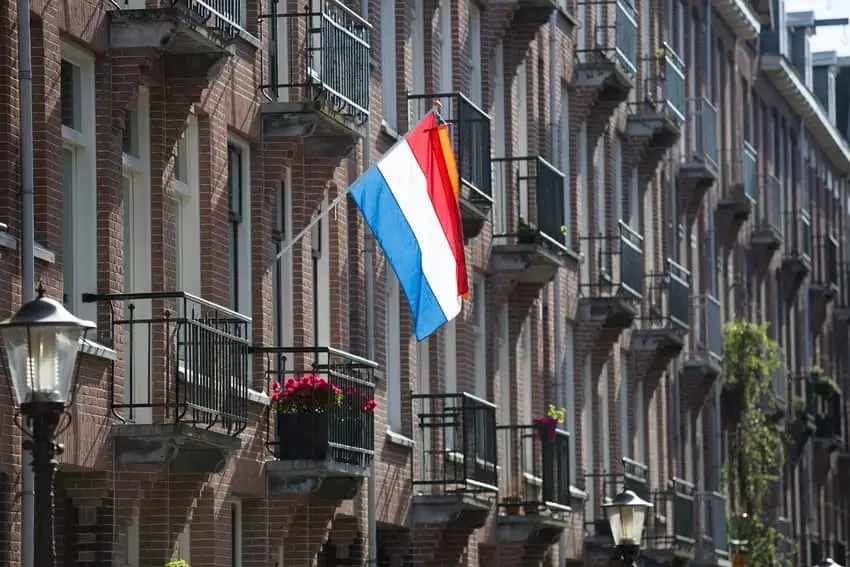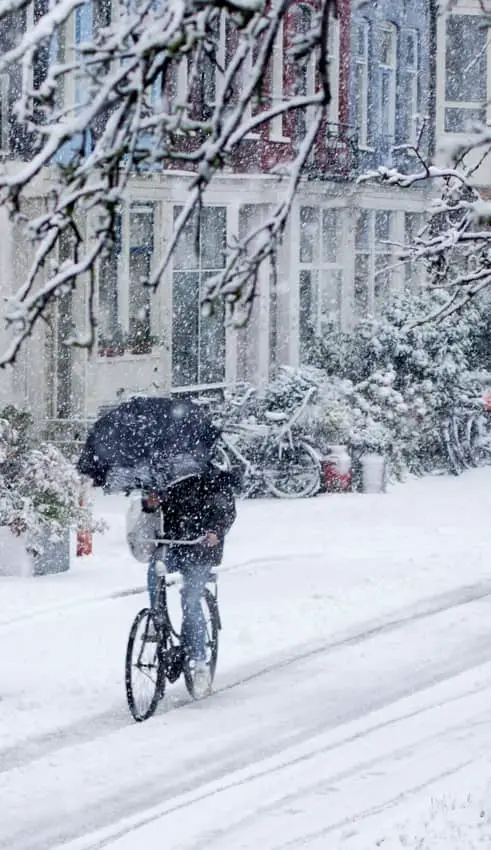The Netherlands has the second lowest number of public holidays in the whole world. In the article, you will find detailed information on when national holidays are observed across the country, as well as short descriptions of school holidays which vary across regions.
In 2020, there will be 20 national and public holidays. Unfortunately, we won’t celebrate all of them because of Coronavirus Pandemic.
Dutch holidays in 2020
| Holiday | Date |
| New Year’s Day | January 1st |
| Good Friday | April 10th |
| Easter Sunday | April 12th |
| Easter Monday | April 13th |
| King’s Day | April 27th |
| National Remembrance Day | May 4th* |
| Liberation Day | May 5th** |
| Ascension Day | May 21st |
| Whit Sunday | May 31st |
| Whit Monday | June 1st |
| Sinterklaas | December 5th*** |
| Christmas Day | December 25th |
| Boxing Day | December 26th |
| New Year’s Eve | December 31st**** |
*May 4th is not an official holiday.
**May 5th is an official holiday this year.
***Sinterklaas is not an official holiday.
****New Year’s Eve is not an official holiday.
Dutch holidays can be divided into three categories. There are national holidays, set by the government (King’s Day and Liberation Day), public holidays when shops and most businesses are closed and most people have a day off (New Year’s Day, Christmas time, Easter holidays etc.) and other holidays that are not considered to be public (like National Remembrance Day or Sinterklaas). Below you will find more info about some of the holiday’s Dutch people celebrate every year.
Koningsdag – King’s Day

Koningsdag is the time of the year when the king’s birthday is celebrated. King’s Day has existed for 5 years now (since King Willem Alexander was crowned) before there was Queen’s Day. The origins of Queen’s Day celebration go back to the day when Queen Wilhelmina was born (August 3rd). Then the date was changed to April 30th (Wilhelmina’s daughter – Juliana’s birthday). Then, Beatrix decided to keep the date and she also celebrated Queen’s Day on April 30th (even if her birthday is on January 31st). Now, since the year 2014, King’s Day has been celebrated on April 27th. The change was announced in 2013 after the queen abdicated from the throne in favor of her son Willem Alexander. If King’s Day falls on Sunday, the celebration is moved to the Saturday before that Sunday.
King’s Day Celebration
Many people consider King’s Day to be the best party in the Netherlands. The day is celebrated with music, street parties, concerts, fun fairs, special events, etc.
Many people spontaneously sing ‘Het Wilhelmus’. The king travels through the country together with his family. In many parts of the Netherlands, the celebration starts on the evening before April 27th. King’s Day is, of course, a public holiday – schools, post offices, banks, and most businesses are closed. Opening hours in stores vary though – some of them are open as usual, some for part of the day only and some are closed all day. There are also special timetables for public transport.
Orange Everywhere

On King’s day, the whole country literally goes orange. T-shirts, accessories, belts, wigs, even shops, and whole streets turn orange for this very day. No matter if you are Dutch, foreigner or tourist, you are supposed to wear orange. Why? It all comes from the history of the Netherlands. The royal family’s full name is House of Oranje which literally means the colour of orange. This is why it became Holland’s national colour. On King’s Day, an orange strip of cloth on the national flag is hung above the flag.
Flea Markets on Konings Dag
On this special day, people are allowed to sell various kinds of items directly on the street. Ban for free trade is lifted and people do not need any particular permit. On King’s Day, you can sell the things you don’t need anymore, you can also sell music, entertainment, etc. If you want to get rid of some of your old junk, this is a perfect opportunity. You aren’t allowed to sell food. Few years before it was fine to sell food but now not anymore.
Dodenherdenking – National Remembrance Day
The National Remembrance Day is held on May 4th. Dodenherdenking is an annual holiday that remembers the soldiers and civilians who died during World War II, other conflicts and peace-keeping operations. Even though World War II ended so many years ago, people in the Netherlands believe it’s important to remember. The official service is held in Amsterdam (at the National Monument), there are conduct speeches, a 2-minute silence and lay wreaths. However, the National Remembrance Day is not a public holiday. Businesses have normal opening hours. On the following day, May 5th, Liberation Day is held in the Netherlands.
A Little Bit of History
During World War II around 7,900 soldiers, 88,900 civilians and 106,000 Jewish compatriots died. On May 5th, 19945 the surrender of the German occupational forces was signed by general Blaskowitz in the Netherlands (town: Wageningen, exact place: Hotel De Wereld). The first Dedenherdenking celebration was held in 1945, on Amsterdam’s Dam Square. Since then, the commemorations have been held across the nation every year.
How Is National Remembrance Day Celebrated
Remembrance gatherings are held everywhere in the country. Thousands of Dutch people participate in the commemorations of National Remembrance Day (survey shows that Dutch people are deeply attached to the traditional commemoration – 90% of people in the Netherlands reflect on the commemorations on May 4th). No matter the age, they observe the 2-minute silence at 8:00 pm on that day in order to pay their respects to those who died. During this 2-minute silence, TV and radio stations broadcast the ceremony, public transport stops, and people stop what they are doing at the moment. There’s also common to hang out the Dutch flag on May 4th. Between 6:00 pm and the sunset the flags are flown at half-mast which signifies the mourning process. The King and various representatives of both the Council of Ministers of the Kingdom of the Netherlands and the Parliament (as well as approximately 20,000 people) are present at the ceremony on Dam Square.
Bevrijdingsdag – Liberation Day

As mentioned above, Liberation Day is held right after National Remembrance Day (May 4th), on May 5th. The main idea behind it is to commemorate the end of the Nazi occupation during the World War II. The holiday has been observed since right after the war. Bevrijdingsdag is a public holiday every five years, on these days schools and most businesses are closed and almost all Dutch people have a day off. Public transport services have special timetables. Very often a debate if May 5th should be a public holiday every year is raised. However, it hasn’t been changed yet. The next date when Liberation Day is a public holiday is May 5th, 2020.
A Little Bit of History
World War II is considered to be one of the most devastating wars in the history. May 5th is the day when people in the Netherlands celebrate liberation by the allies from the Nazi occupation. The country was occupied for 5 years, since Rotterdam was bombed by Nazi Germany in May 10th, 1940. After five years the Netherlands was liberated by the Canadian officers.
Liberation Day – Celebration
Nowadays, Liberation Day doesn’t only celebrate the end of occupation. As times goes by, holiday’s character has evolved and in the last couple of years the holiday is about celebrating freedom in general. As young generations cannot even imagine what’s like to live in an occupied country, they mostly celebrate life, freedom, an opportunity to live, work and developed in a free society. There are many special events on that day, both national and local. There are various festivals and celebrations every year. Among the others, the Liberation Festival in Amsterdam is held. The festival showcases the talents of both Dutch and foreign musicians. There isn’t any entrance fee. In short, music is heard in various places in the city during live performances. Besides the Liberation Festival you can also visit the Vrijland Festival and Het Amsterdams Verbond at Tuinen van West. Both have quite extensive line-ups. While speaking of special events, there is one recommendable concert to visit – the Amstel Concert. Musicians from various musical genres perform on a floating podium.
Sinterklaas – Saint Nicholas

Sinterklaas is probably one of the favourite holidays in Dutch children’s opinion. It’s kind of celebrated for two days – on December 5th is Sinterklaas Eve and on December 6th is Sinterklaas Day. A legendary figure – Saint Nicholas – visits children and brings them gifts. His main entrance takes place in different city each year. However, almost all Dutch cities have their own arrival of Saint Nicholas. Sinterklaas Day is not a public holiday in the Netherlands, all businesses have normal opening hours. However, there are many businesses dedicated to Sinterklaas holiday. Those days, during this time of the year, they are especially busy.
Who’s Saint Nicholas?
The legendary figure is derived from Nicholas of Myra (Myra is now Turkey). Nicholas of Myra officiated as a bishop in 4th century. From the 11th century, dozens of his miracles has been believed to happen around Western Europe. This is why he became the patron saint of all sections of society, no matter the age. Saint Nicholas, is an old man with eye-catching red cape with red miter and a long white beard. He and his helpers (all referred to as ‘Zwarte Piet’) arrives in mid-November on a steam boat filled with gifts.
What Do Children Do to Get Presents from Saint Nicholas
In order to be gifted, kids have to put their shoes next to the chimney or back door. Sinterklaas appears at night, he rides across the rooftops on his white horse called Amerigo. Then Saint Nicholas leaves gifts in the children’s shoes. He also places some traditional Dutch sweets there, like the following ones: spiced biscuits, marzipan, gingerbread, chocolate letters. The rule is simple – if children have been good, they will find gifts in their shoes. Besides, some kids think that they can get around the Sinterklaas by leaving a carrot for his horse, together with a wish list. In some places, it’s still common to run ‘public appearances’ of Saint Nicholas and his crew. They visit children in schools, shopping malls and hospitals. Sinterklaas gives away presents and toys and children sing special songs to honour him.
Tweede Kerstdag – Boxing Day
December 26th is the second day of Christmas. It’s kind of the continuation of the Christmas holiday for most Dutch people. It’s actually called the Saint Stephen’s day. Saint Stephen live around the similar time as Jesus and he was tried for blasphemy and stoned to death. He was responsible for distributing help. The holiday is celebrated similarly to the Christmas Day. It was introduced to facilitate going to church multiple times and to have some time to think, relax and contemplate. The day commemorates times when three men visit to Jesus. The feast (12 days) reflects the winter festivals in Europe during the pre-Christian times.
Boxing Day Celebration
Boxing Day is a public holiday. For most people in Holland it’s a day off. Schools and businesses are closed. Public transport services operate, but a slightly reduced service. People just spend their time preparing food for their friends and relatives, then they just eat it and have some quality time with people they are close with. Very often couples spend Christmas at their partner’s parental home. It’s common to go for a walk, cycle, take part in some sport competitions etc. There are also Christmas markets with ice skating, theatre performances, movies and musicals to take part in. what might be interesting for a foreigner, there are some restrictions on selling alcohol on December 26th,
Dutch Christmas
Dutch holiday season starts very early, as in whole Europe. For Dutch people, it’s a perfect occasion to prepare some special food and celebrate the event with family and friends. Dutch Christmas starts on December 24th when it’s time to go to church. In Dutch families, there is also a tradition to have a snack eaten in the early hours upon arriving home when Christmas Day is broken. On the next day, this is a family time. There’s a family breakfast and a dinner. If you happen to be in the Netherlands on Christmas do not forget to try the famous Dutch almond Christmas pastry ring. On the last Christmas Day, December 26th, Dutch people see the rest of their family, go to gentle walks etc. On this day, most shops are also closed.
School Holidays in the Netherlands

On top of the above-mentioned holidays, kids in the Netherlands also have a school-free period in the summer and two in the winter. Of course, there are also some holidays in the spring, summer and autumn. You should know that Dutch schools are divided into regions: North, Central and South. Each of them has its own holiday schedule. Otherwise, a holiday rush wouldn’t be possible to avoid – the whole country would go on holiday the same week. So, if you need to plan for school holidays in Holland, do not forget that the holiday dates may vary depending on your child’s school location. What’s more, there are also privately-run international schools. Their holiday dates may also be a but different from the rest of schools in the very same region.
Some More Details on the Regions
Dutch schools are broken out by province across three regions. The North includes Amsterdam, Groningen, Drenthe, Flevoland (except Zeewolde), Overijssel, Friesland. The Central includes The Hague, Rotterdam, Delft, northern Gelderland, Utrecht (except Eemnes), Zeewolde, Woundrichem, and Werkendam. The South region includes southern Gelderland, Limburg, Zeeland, northern Brabant (except Woundrichem and Werkendam). Dutch schools have five holidays throughout the year (autumn, Christmas, spring, May, and summer). Three of them vary depending on the region – autumn holiday (1 week), spring holiday (1 week) and summer holiday (6 weeks).
In 2020, school holiday dates will look slightly different:
| School Holiday | Dates |
| Spring break | 17.-28.02. – depends on the region* |
| May Holiday | 27.04. – 1.05. (all regions) |
| Summer Holiday | 6.07. – 28.08.** |
| Autumn Break | 12.10. – 23.10.*** |
| Christmas Holiday | 21.12. – 1.01. (all regions) |
*South, Rotterdam, The Hague and Central: Feb 24th – Feb 28th,
Amsterdam and North – Feb 17th – Feb 21st.
** South – Jul 13th – Aug 21st,
Central – Jul 20th – Aug 28rd,
North – Jul 6th – Aug 14th.
*** South and Central – Oct 19th – Oct 23rd,
North – Oct 12th – Oct 16th.
School holidays in the Netherlands take place in 2019
| School Holiday | Dates |
| Spring break | 16.-22.02. – depends on the region* |
| May Holiday | 29.04. – 3.05. (all regions) |
| Summer Holiday | 8.07. – 30.08.** |
| Autumn Break | 14.10. – 25.10.*** |
| Christmas Holiday | 23.12. – 3.01. (all regions) |
*South, Rotterdam, The Hague and Central: Feb 23rd – March 3rd,
Amsterdam and North – Feb 16th – Feb 24th.
** South – Jul 8th – Aug 16th,
Central – Jul 15th – Aug 23rd,
North – Jul 13th – Aug 30th.
*** South – Oct 14th – Oct 18th,
Central and North – Oct 21st – Oct 25th.
Dutch holidays in 2019
| Holiday | Date |
| New Year’s Day | January 1st |
| Good Friday | April 19th |
| Easter Sunday | April 21st |
| Easter Monday | April 22nd |
| King’s Day | April 27th |
| National Remembrance Day | May 4th* |
| Liberation Day | May 5th** |
| Ascension Day | May 30th |
| Whit Sunday | June 9th |
| Whit Monday | June 10th |
| Sinterklaas | December 5th*** |
| Christmas Day | December 25th |
| Boxing Day | December 26th |
| New Year’s Eve | December 31st**** |
*May 4th is not an official holiday.
**May 5th is not an official holiday this year.
***Sinterklaas is not an official holiday.
****New Year’s Eve is not an official holiday.
Summary
Now, you know almost everything about the holidays observed in the Netherlands. Personally, the one I like most is King’s Day – the whole country literally goes crazy which is extremely interesting to watch at, especially if you’re a foreigner. If you are planning your trip to Holland next year, make it in the spring, in the end of April. You’ll have a unique opportunity to celebrate King’s birthday with the Dutch and fall in love with the tulips in their full bloom.
